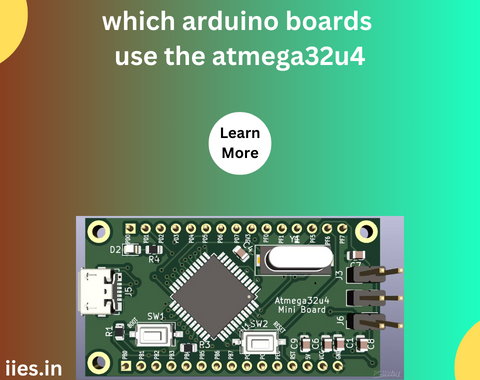
Arduino, an open-source electronics platform, has gained immense popularity for its simplicity and versatility in the world of DIY electronics and prototyping. Among the various Arduino boards available, the ATmega32U4 microcontroller has found its way into several models, offering unique features and capabilities. In this article, we’ll delve into the world of Arduino boards equipped with the ATmega32U4, exploring their applications, specifications, and advantages.
One of the first Arduino boards to incorporate the ATmega32U4 microcontroller is the Arduino Leonardo. Launched in 2012, the Leonardo marked a significant departure from its predecessors by featuring built-in USB communication capabilities. The ATmega32U4, with its integrated USB controller, allowed the Leonardo to emulate a keyboard or mouse, opening up new possibilities for interactive projects and Human Interface Devices (HID).
The Leonardo’s compact form factor and the inclusion of a micro USB port for programming and power make it an ideal choice for projects where space is a constraint. Its ability to act as a USB device, combined with the power of the ATmega32U4, provides flexibility for creative projects ranging from simple input devices to complex interactive installations.
Arduino Micro:
Building upon the success of the Leonardo, the Arduino Micro is another board that features the ATmega32U4 microcontroller. Released in 2012 alongside the Leonardo, the Micro shares many similarities with its sibling but comes in a smaller form factor. The Arduino Micro is designed to be even more compact, making it suitable for applications where space is at a premium.
Despite its smaller size, the Micro retains the powerful capabilities of the ATmega32U4, making it a versatile choice for projects that demand both performance and a compact design. With the ability to emulate USB devices and a range of input options, the Arduino Micro continues to be a popular choice for hobbyists and professionals alike.
Arduino Esplora:
The Arduino Esplora is a unique board in the Arduino lineup, designed specifically for game development and interactive projects. Released in 2012, the Esplora features the ATmega32U4 microcontroller at its core. What sets the Esplora apart is its integrated sensors and controls, including a joystick, slider, and a variety of buttons.
The combination of the ATmega32U4’s USB capabilities and the built-in input devices makes the Esplora an excellent choice for creating gaming consoles, interactive exhibits, or any project that requires intuitive user interfaces. Its out-of-the-box functionality reduces the need for additional components, simplifying the prototyping process for those exploring the world of interactive electronics.
Arduino Lilypad USB:
Targeted towards wearable electronics and e-textile projects, the Arduino Lilypad USB is a unique board that utilizes the ATmega32U4 microcontroller. Launched in 2012, the Lilypad USB is designed with flexibility and durability in mind. Its round shape and sewable design make it suitable for integration into clothing, providing a platform for electronic fashion and wearable tech.
The Lilypad USB leverages the ATmega32U4’s USB capabilities for easy programming and communication with other devices. Its compatibility with various sensors and actuators allows creators to explore innovative applications in the realm of smart clothing, health monitoring, and interactive fashion.
Pro Micro and SparkFun Pro Micro:
While not directly branded as Arduino products, the Pro Micro and SparkFun Pro Micro are third-party boards that utilize the ATmega32U4 microcontroller. These compact boards, available in different versions, offer a stripped-down design while retaining the essential features of the ATmega32U4.
The Pro Micro and SparkFun Pro Micro are favored by enthusiasts and professionals for their small size and affordability. They are often used in projects where space constraints are critical, such as in custom keyboards, game controllers, and compact wearable devices.
Advantages of ATmega32U4 in Arduino Boards:
Built-in USB Communication:
The key advantage of Arduino boards featuring the ATmega32U4 is their built-in USB communication capabilities. This allows these boards to emulate USB devices, opening up possibilities for creating custom input devices, game controllers, and interactive installations.
Versatility in Input Options:
The ATmega32U4 supports a variety of input options, including analog and digital pins, making it versatile for a wide range of projects. The ability to handle different types of sensors and actuators enhances the creative potential of these boards.
Compact Form Factor:
Boards like the Arduino Micro and Pro Micro are designed to be compact, making them suitable for projects with limited space. This compact form factor doesn’t compromise the capabilities of the ATmega32U4, allowing for powerful performance in a small package.
Compatibility with Arduino IDE:
All Arduino boards with the ATmega32U4 are compatible with the Arduino Integrated Development Environment (IDE). This ensures a user-friendly programming experience, making it accessible to beginners while offering advanced features for experienced developers.
Arduino boards featuring the ATmega32U4 microcontroller have played a pivotal role in expanding the possibilities of DIY electronics and prototyping. Whether you’re creating interactive art installations, wearable tech, or custom input devices, the ATmega32U4’s USB capabilities, versatility, and compact design make it a compelling choice for a wide range of projects. As the world of electronics continues to evolve, these Arduino boards with the ATmega32U4 are likely to remain at the forefront of innovation, empowering creators to bring their ideas to life.
Indian Institute of Embedded Systems – IIES